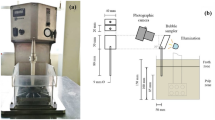Abstract
To investigate effect of metallic ion activation on different particle sizes of quartz in butyl xanthate solution, six common ions (Pb2+, Cu2+, Fe3+, Fe2+, Mg2+ and Ca2+) were introduced as activators. The approaches of micro-flotation, adsorption test and zeta potential measurement were adopted to reveal the mechanism of ion activation. The results show that Pb2+, Cu2+ and Fe3+ are effective activators for the flotation of quartz in butyl xanthate solution because of their absorption on activated quartz surface. Average recoveries of fine particles (<37 μm) are greater than those of coarser particles (37−74 μm), suggesting that the former is easier to be activated and more likely to be floated and thus entrained in sulphide concentrate. From another perspective, addition of metallic ions (Pb2+, Cu2+ and Fe3+) renders zeta potentials move positively, and addition of the same metallic ions and butyl xanthate makes zeta potential drop apparently, which support a mechanism where they adsorb onto quartz surface, resulting in an expected increase in butyl xanthate collector adsorption with a concomitant increase in the flotation recoveries.
Similar content being viewed by others
References
LIU Wen-gang, LIU Wen-bao, WANG Xin-yang, WEI De-zhou, WANG Ben-ying. Utilization of novel surfactant N-dodecylisopropanolamine as collector for efficient separation of quartz from hematite [J]. Separation and Purification Technology, 2016, 162: 188–194.
ZHU Hai-ling, DENG Hai-bo, CHEN Chen. Flotation separation of andalusite from quartz using sodium petroleum sulfonate as collector [J]. Transactions of Nonferrous Metal Society of China, 2015, 25(4): 1279–1285.
ABIDI A, ELAMARI K, BACAOUI A, YACOUBI A. Entrainment and true flotation of a natural complex ore sulfide [J]. Journal of Mining Science, 2014, 50(6): 1061–1068.
YIANATOS J, VINNETT L, CARRASCO C, ALVAREZ-SILVA M. Effect of entrainment in bubble load measurement on froth recovery estimation at industrial scale [J]. Minerals Engineering, 2015, 72: 31–35.
ALBIJANIC B, OZDEMIR O, HAMPTON M A, NGUYEN P T, NGUYEN A V, BRADSHAW D. Fundamental aspects of bubble-particle attachment mechanism in flotation separation [J]. Minerals Engineering, 2014, 65: 187–195.
BASAROVA P, HUBICKA M. The collision efficiency of small bubbles with large particles [J]. Minerals Engineering, 2014, 66-68: 230–233.
VERRELLI D I, ALBIJANIC B. A comparison of methods for measuring the induction time for bubble–particle attachment [J]. Minerals Engineering, 2015, 80: 8–13.
LI Hong-qiang, FENG Qi-ming, YANG Si-yuan, OU Le-ming, LU Ying. The entrainment behaviour of sericite in microcrystalline graphite flotation [J]. International Journal of Mineral Processing, 2014, 127: 1–9.
EJTEMAEI M, IRANNAJAD M, GHARABAGHI M. Role of dissolved mineral species in selective flotation of smithsonite from quartz using oleate as collector [J]. International Journal of Mineral Processing, 2012, 114-117: 40–47.
ZHANG Zhi-zhen, LI Jing-sheng, LI Xiao-xia, HUANG Hou-quan, ZHOU Li-fen, XIONG Tian-tian. High efficiency iron removal from quartz sand using phosphoric acid [J]. International Journal of Mineral Processing, 2012, 114-117: 30–34.
ZHU Yang-ge, ZHANG Guo-fan, FENG Qi-ming, YAN Dai-cui, WANG Wei-qing. Effect of surface dissolution on flotation separation of fine ilmenite from titanaugite [J]. Transactions of Nonferrous Metal Society of China, 2012, 21(5): 1149–1154.
ZHANG Jie, WANG Wei-qing, LIU Jing, HUANG Yang, FENG Qi-ming, ZHAO Hong. Fe(III) as an activator for the flotation of spodumene, albite, and quartz minerals [J]. Minerals Engineering, 2014, 61: 16–22.
WANG Dian-zuo, HU Yue-hua. The investigation of role of surface precipitation of meta hydroxide in flotation of quartz [J]. Journal of Central South University of Technology, 1990, 21(3): 248–253. (in Chinese)
FORNASIERO D, RALSTON J. Cu(II) and Ni(II) activation in the flotation of quartz, lizardite and chlorite [J]. International Journal of Mineral Processing, 2005, 76(1-2): 75–81.
SHI Yun-liang, QIU Guan-zhou, HU Yue-hua, CHEN Chun. Surface chemical reaction of quartz in flotation [J]. Mining and Metallurgical Engineering, 2001, 21(3): 43–48. (in Chinese)
OU Le-ming, YE Jia-sun, ZENG Wei-wei, WAN Li. Influence and mechanism of ferric and ferrous ions on flotation of smithsonite and quartz [J]. Nonferrous Metals: Mineral Processing Section, 2012(6): 79–82. (in Chinese)
OU Le-ming, HUANG Si-jie, ZHU Yang-ge. Influence of metal ions on floatability of quartz in flotation of sulfide ores [J]. Journal of Central South University: Science and Technology, 2012, 43(2): 407–11. (in Chinese)
WANG Li, SUN Wei, HU Yue-hua, XU Long-hua. Adsorption mechanism of mixed anionic/cationic collectors in muscovite-quartz flotation system [J]. Minerals Engineering, 2014, 64: 44–50.
ZHANG Kang. The study on improving the flotation performance for quartz purification [D]. Guangzhou: South China University of Technology, 2013: 19–21. (in Chinese)
Author information
Authors and Affiliations
Corresponding author
Additional information
Foundation item: Project(51274255) supported by the National Natural Science Foundation of China; Project(2015CX005) supported by Innovation Driven Plan of Central South University, China; Project(2016RS2016) supported by Hunan Provincial Science and Technology Leader (Innovation Team of Interface Chemistry of Efficient and Clean Utilization of Complex Mineral Resources), China; Project supported by the Postdoctoral Research Station of Central South University, China
Rights and permissions
About this article
Cite this article
Qin, Wq., Wu, Jj. & Jiao, F. Mechanism of different particle sizes of quartz activated by metallic ion in butyl xanthate solution. J. Cent. South Univ. 24, 56–61 (2017). https://doi.org/10.1007/s11771-017-3408-x
Received:
Accepted:
Published:
Issue Date:
DOI: https://doi.org/10.1007/s11771-017-3408-x




